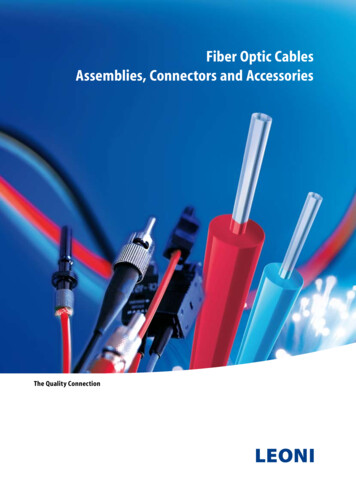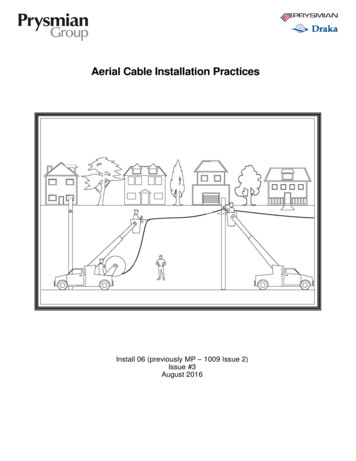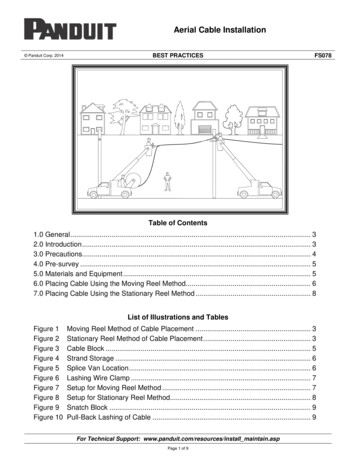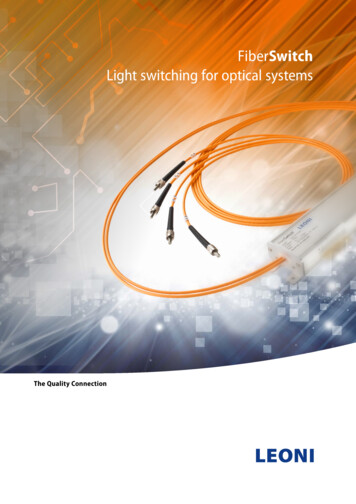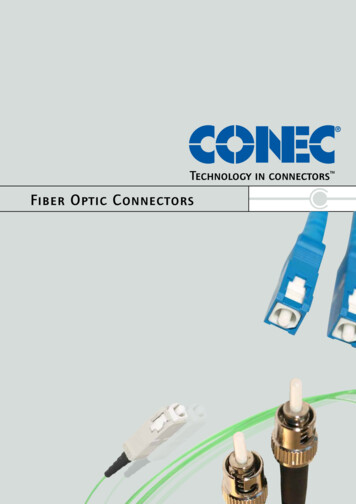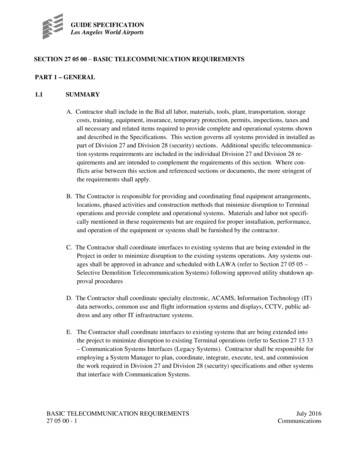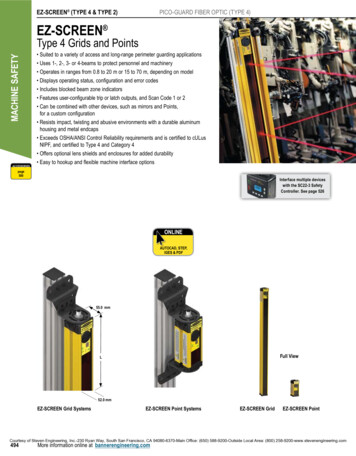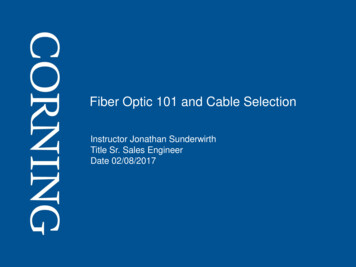
Transcription
Fiber Optic 101 and Cable SelectionInstructor Jonathan SunderwirthTitle Sr. Sales EngineerDate 02/08/2017
AgendaWhat Are We Going To Learn Today? Overview of Corning Cable Systems Fiber Optic Technology 101–––––What is it?How does it work?Fiber TypesFiber PerformanceBenefits Fiber Optic Cable 101––––What is it?Cable ConstructionHow to Pick a Fiber Optic CablePulling Best Practices Fiber Optic Termination Methods Installing a Fiber Optic System– Components of an installation Review of Corning Cable Systems Offerings.Corning RestrictedRestrictedCorning2.
Overview of Corning Cable SystemsEnterprise Networks: Solutions for Your ApplicationLANData CenterHarshEnvironment.Corning RestrictedRestrictedCorning3.
AgendaWhat Are We Going To Learn Today? Overview of Corning Cable Systems Fiber Optics Tecnology101 What is it?How does it work?Fiber PerformanceFiber TypesBenefits Fiber Optic Cable 101––––What is it?Cable ConstructionHow to Pick a Fiber Optic CablePulling Best Practices Fiber Optic Termination Methods Installing a Fiber Optic System– Components of an installation Review of Corning Cable Systems Product Offerings.Corning RestrictedRestrictedCorning4.
Fiber Optics 101What Is Fiber Optics?General DefinitionTransmitting information in the form of light, through a transparentmedium, typically high-purity glassMediumAny material through which energy moves, over a distanceExamples:Sound through waterRadio Signals through airLight through high-purity glass.Corning RestrictedRestrictedCorning5.
Fiber Optics 101What Is Fiber Optics?Light Transmitting Through Glass Reference: Corning RestrictedRestrictedCorning6.
Fiber Optics 101Properties of Electromagnetic SignalsWavelengthThe distance between identical points on a wave(typically expressed in nanometers or “nm”)wavelengthLow frequencyA.1 secondwavelengthHigh frequencyB.1 second“B” represents a shorter wavelength than “A”.Corning RestrictedRestrictedCorning7.
Fiber Optics 101Electromagnetic SpectrumWavelengthMultimodeSingle-modeλnm420UV Spectrum700Visible Spectrum8501300 1310149015501625Infrared SpectrumOperating Wavelengths: 850 nm Short Wave Multimode 1300 nm Long-Wave Multimode 1310 nm Traditional Standard Single-mode 1490 nm FTTx (Downstream Data/Voice) 1550 nm Long-Wave Single-mode 1625 nm Extra Long-Wave Single-mode (WDM).Corning RestrictedRestrictedCorning8.
Fiber Optics 101Measuring Fiber Optics A micrometer, or micron ( m), is a metric measurement used tomeasure the diameter of a fiber.– One micron 1 x 10-6 meters, one millionth of a meter.– One micron 0.000039 inches– One human hair is 80 microns A coated optical fiber is about 250 m in diameter The light carrying region of an optical fiber can be as small as 10 m or less. In optical fiber, some specifications are as tight as 0.5 m!.Corning RestrictedRestrictedCorning9.
Fiber Optics 101Relative size of optical fiber.Corning RestrictedRestrictedCorning10.
Fiber Optics 101Principles of Operation — TheoryCross section of a typical fiber Core– Carries the light signals245 μm125 μm8 - 62.5 μm Cladding– Keeps the light in the core– Can not be separated fromthe Core Coating– Protects the glass– Acrylate (plastic)CORECLADDINGCOATING.Corning RestrictedRestrictedCorning11.
AgendaWhat Are We Going To Learn Today? Overview of Corning Cable Systems Fiber Optics Tecnology101 What is it?How does it work?Fiber PerformanceBasic Fiber TypesBenefits Fiber Optic Cable 101––––What is it?Cable ConstructionHow to Pick a Fiber Optic CablePulling Best Practices Fiber Optic Termination Methods Installing a Fiber Optic System– Components of an installation Review of Corning Cable Systems Product Offerings.Corning RestrictedRestrictedCorning12.
Fiber Optics 101How Does It Work?Couple the light into the fiber and keep it there:“Total Internal Reflection”Refractedand LostReflectedInternally.Corning RestrictedRestrictedCorning13.
AgendaWhat Are We Going To Learn Today? Overview of Corning Cable Systems Fiber Optics Tecnology101 What is it?How does it work?Fiber PerformanceBasic Fiber TypesBenefits Fiber Optic Cable 101––––What is it?Cable ConstructionHow to Pick a Fiber Optic CablePulling Best Practices Fiber Optic Termination Methods Installing a Fiber Optic System– Components of an installation Review of Corning Cable Systems Product Offerings.Corning RestrictedRestrictedCorning14.
Fiber Optics 101Fiber Performance is Measured in BandwidthBandwidthThe capacity of a medium to carry information over a distancewithout loss of data(How much data can I carry and how far?) Affected by– Source/Transmitter (the LASER, VCSEL, or LED) Nominal wavelength, Spectral Width, Time Delays– Waveguide (the fiber) Attenuation* Dispersion**Both are affected by distance traveled.Corning RestrictedRestrictedCorning15.
Fiber Optics 101Optical Sources Types– LED Light Emitting Diode Low cost (850nm, 1300nm)– LASER Light Amplification from the StimulatedEmission of Radiation High cost (1310nm, 1550 nm, 1625nm)– VCSEL Vertical Cavity Surface Emitting Laser Lower cost laser (850nm) Characteristics– Time Delay - Lag time of source to power up and power down– Spectral Width.Corning RestrictedRestrictedCorning16.
Fiber Optics 101Waveguide (the Fiber) Effects Attenuation – loss of signal strength–––––Expressed in decibels of power lost (dB)Intrinsic AttenuationExtrinsic AttenuationImpacts ability to reach the receiver with sufficient powerA 3dB loss in power equates to a 50% loss from what you startedwith Dispersion – spreading of signal pulses– Modal Dispersion– Chromatic Dispersion– Impacts the ability to distinguish discreet signal pulses.Corning RestrictedRestrictedCorning17.
Fiber Optics 101Impact of dB LossOptical Loss of Power (%)0%10%20%30%40%50%60%70%80%Optical Loss of Power (dB)0-1-2-33 dB 50 % LossFor every 3dB loss ofoptical power, youloose 50% of what youhad before the“divorce law”-4-5-6-7-8.Corning RestrictedRestrictedCorning18.
Fiber Optics 101Intrinsic AttenuationIntrinsic AttenuationLoss of signal energy due to interaction between the photons andinherent physical properties of the fiber(Internal - Can’t be affected by outside influences) AbsorptionPhotons give upkinetic energy tosubatomic particles ScatteringPhotons bounce offsubatomic particles.Corning RestrictedRestrictedCorning19.
Fiber Optics 101Extrinsic AttenuationExtrinsic AttenuationLoss of signal energy due to change in dimensional properties ofthe fiber(External - Caused by outside influences) Macrobends Microbends Imperfect Junctions– Splices– Fiber endfaces.Corning RestrictedRestrictedCorning20.
Fiber Optics 101Extrinsic AttenuationMacrobendLarge-scale bend of the waveguide, which changes the angle ofincidence of previously reflecting modes(Generally across entirecross-section of the fiber).Corning RestrictedRestrictedCorning21.
Fiber Optics 101Extrinsic AttenuationMicrobendSmall-scale distortion of the waveguide, which changes the angleof incidence of previously reflecting modes(Might affect only one side of the core).Corning RestrictedRestrictedCorning22.
Fiber Optics 101DispersionDispersionSpreading of signal pulses as they travel down the fiber(May cause pulses to overlap as they arrive at the receiver, andcause bit errors)FiberTransmittedSignal PulsesReceivedSignal Pulses.Corning RestrictedRestrictedCorning23.
Fiber Optics 101Dispersion – Bit Error0TheoreticalInput1Actual Input101010AcceptablePulseBroadeningToo MuchPulseBroadening.Corning RestrictedRestrictedCorning24.
AgendaWhat Are We Going To Learn Today? Overview of Corning Cable Systems Fiber Optics Tecnology101 What is it?How does it work?Fiber PerformanceBasic Fiber TypesBenefits Fiber Optic Cable 101––––What is it?Cable ConstructionHow to Pick a Fiber Optic CablePulling Best Practices Fiber Optic Termination Methods Installing a Fiber Optic System– Components of an installation Review of Corning Cable Systems Product Offerings.Corning RestrictedRestrictedCorning25.
Fiber Optics 101Basic Types of FiberModeA single stream of photons that travels in a straight line unlessacted upon by the environmentA ray of light Single-mode (SM)– Narrow Core ( 8.3µm)– Supports only one ray / mode8.3 µm Multimode (MM)– Broader Core (50-62.5µm)– Supports many rays / modes50 µm or 62.5 µmNote: More Modes More Bandwidth.Corning RestrictedRestrictedCorning26.
Fiber Optics 101Basic Types of FiberSingle-mode FiberMultimode FibersOM2, OM3, OM4OM1OS2CoreCoreCore 62.5 µm 50 µm 8 µmCladdingCladdingCladding 125 µm 125 µm 125 µmCarries SignalKeeps Light in CoreCoatingCoatingCoating 250 µm 250 µm 250 µmProtects The GlassInformation Carrying Capacity.Corning RestrictedRestrictedCorning27.
Fiber Optics 101Basic Types of FiberMultimodeFiber 62.5 µm 50 µmSingle-modeFiber 9 µm.Corning RestrictedRestrictedCorning28.
Fiber Optics 101Comparing Single-mode and Multimode FibersSingle-mode Core Size (8.3 µm) Sources– Lasers 1310, 1550, 1625nm Attenuation (typical)– 0.35/0.25 dB/km(1310/1550) Dispersion– No Modal Dispersion– Bandwidth: Limited by electronics onlyMultimode Core Size (62.5 or 50 µm) Sources– LED or VCSEL 850 or 1300nm Attenuation (typical)– 3.5/1.5 dB/km (850/1300) Dispersion– Dominated by Modal Disp.– Bandwidth: Limited Distance Fiber Type Source Type.Corning RestrictedRestrictedCorning29.
Fiber Optics 101Types of Single-mode and Multimode FibersSingle-mode OS2 – SMF28e NZ-DSF – LEAF Corning ClearCurve – 5 mm bend radius– Compatible with current SMfibers, equipment, &proceduresMultimode OM1 – LANscape 62.5µm OM2 – LANscape Pretium 150(50µm) OM3 – LANscape Pretium 300(50µm) OM4 – LANscape Pretium 550(50µm) Corning ClearCurve – Industry leading macrobendingperformance below 10 mm radius– Available in OM2, OM3, & OM4.Corning RestrictedRestrictedCorning30.
Fiber Optics 101Comparing Multimode Fibers62.5 µmCoreCladding(125 µm)50 µm(62.5µm)CoreCoatingCladding(250 µm)(125 µm)(50 µm)Coating(250 µm)Only evident physical difference is core size: 50 µm has greater bandwidth due to smaller core 50 µm has fewer modes less modal dispersion.Corning RestrictedRestrictedCorning31.
Fiber Optics 101Comparing Multimode Fibers50 µm Greater bandwidth Extended GigE and FiberChannel range Accepted by TIA/EIA-568C We see more 50 µm in datacenters Industry moving toward 50micron fiber for bandwidth62.5 µm Lower bandwidth Decreased range at 850nm Accepted by TIA/EIA-568C Greater installed base Previously the only MMfiber accepted by TIA/EIA568CNote: MM fiber types should not be not mixed within the same LAN.Corning RestrictedRestrictedCorning32.
Fiber Optics 101Choosing Single-mode vs. Multimode FibersSingle-mode Applications:– Backbones, longhaul, FTTx Advantages:– Longer lengths– Higher data rate systems Video, gaming– Lower attenuation– Lower dispersion Disadvantages:– More expensive sources– More difficult to align coresMultimode Applications: DataCenters, LAN Advantages:– Easier core alignment– Less expensive sources– Less expensive connectors /adapters Disadvantages––––Shorter lengthsLower data rate systemsModal DispersionHigher attenuation.Corning RestrictedRestrictedCorning33.
Fiber Optics P(CatUTP.5)1009080706050403020100.3)kilometersWhy Fiber? - Longer Distances ** Typical distance for 1 Gbps system capability.Corning RestrictedRestrictedCorning34.
Fiber Optics 101kilometersDistances * (without 3ta(CPUT).5ta(CPUT).6ta(CPSTalix-aoCMtimlueod* Typical distance for 1 Gbps system capability.Corning RestrictedRestrictedCorning35.
Fiber Optics 101SM and MM Fiber Distance Capabilities.Corning RestrictedRestrictedCorning36.
AgendaWhat Are We Going To Learn Today? Overview of Corning Cable Systems Fiber Optics Tecnology101 What is it?How does it work?Fiber PerformanceBasic Fiber TypesBenefits Fiber Optic Cable 101––––What is it?Cable ConstructionHow to Pick a Fiber Optic CablePulling Best Practices Fiber Optic Termination Methods Installing a Fiber Optic System– Components of an installation Review of Corning Cable Systems Product Offerings.Corning RestrictedRestrictedCorning37.
Fiber Optics 101Benefits of Optical FiberFeaturesBenefitsLow insertion lossLonger distancesHigh bandwidthGreater information capacityImmune to EMI & RFINo crosstalkDifficult to tapSecure.Corning RestrictedRestrictedCorning38.
Fiber Optics 101Benefits of Optical FiberFeaturesBenefitsDielectric constructionEliminates groundingconsiderations/shock hazardsLight weight/small sizeLonger pulls possibleMinimal space usedApplicationindependentSupports data, voice, video,process control, etc.Corning RestrictedRestrictedCorning39.
Fiber Optics 101Intrinsic Strength the Facts! Measured fiber intrinsic strength compared to other ing.Corning RestrictedRestrictedCorning40.
Fiber Optics 101Fiber versus Copper A fiber optic cable with the same bandwidth capacity as a comparablecopper cable is less than 1% of both the size and weightFiber optic cable vs CAT6 copper cable.Corning RestrictedRestrictedCorning41.
AgendaWhat Are We Going To Learn Today? Overview of Corning Cable Systems Fiber Optics 101–––––What is it?How does it work?Fiber TypesFiber PerformanceBenefits over Copper Fiber Optic Cable 101 What is it?Cable ConstructionHow to Pick a Fiber Optic CablePulling Best Practices Fiber Optic Termination Methods Installing a Fiber Optic System– Components of an installation Review of Corning Cable Systems Offerings.Corning RestrictedRestrictedCorning42.
Fiber Optic Cable 101What is Fiber Optic Cable?General Definition:Fibers packaged and bundled together for maximum mechanicaland physical protection.Standard Types: Indoor Tight Buffered Cables Outdoor Cables Indoor/Outdoor Cables– Tight Buffered– Loose Tube.Corning RestrictedRestrictedCorning43.
AgendaWhat Are We Going To Learn Today? Overview of Corning Cable Systems Fiber Optics 101–––––What is it?How does it work?Fiber TypesFiber PerformanceBenefits over Copper Fiber Optic Cable 101 What is it?Cable ConstructionHow to Pick a Fiber Optic CablePulling Best Practices Fiber Optic Termination Methods Installing a Fiber Optic System– Components of an installation Review of Corning Cable Systems Offerings.Corning RestrictedRestrictedCorning44.
Fiber Optic Cable 101Fiber Coloring Purpose– Provides fiber identification Coloring ink applied directly on thecoated fiber. Standard US Color Code– Blue, orange, green, brown, slate,white, red, black, yellow, violet, lowVioletRoseAqua.Corning RestrictedRestrictedCorning45.
Fiber Optic Cable 101Cable Jacket Identification Purpose– Provides fiber type identification (Indoor Cables)– Provides UV protection (Outdoor Cables)Orange OM1and OM2Yellow OS2(SM)Aqua OM3 andOM4Black OutdoorCables.Corning RestrictedRestrictedCorning46.
Fiber Optic Cable 101Indoor Tight Buffered Cable Primarily used indoors (exception: FREEDM One)– Building and data center backbones– Horizontal applications– Patch cords and equipment cables Meet applicable flame listing requirementsIncreased flexibilityEasy to field-terminateVariety of fiber counts and cable designs.Corning RestrictedRestrictedCorning47.
Fiber Optic Cable 101Tight-Buffered Fiber Construction Buffer material applied directly to the 250 µm fiber to obtain a 900 µmouter diameter To construct cable, 900 µm may be– Stranded or unitized Lacks environmental and mechanical robustness of Loose Tube cableCoating(250µm)TBII ProcessOpticalfiber(125 µm)ThermoplasticCoating900 µm.Corning RestrictedRestrictedCorning48.
Fiber Optic Cable 101Tight-Buffered Fiber Construction TBII Buffered Fiber uses a patented process that allows foreasy removal of the buffering material for splicing orconnectorization.Corning RestrictedRestrictedCorning49.
Fiber Optic Cable 101Indoor Tight-Buffered Cable ManufacturingMultifiberSingle-FiberRaw material (fiber)Raw material (fiber)Fiber bufferingFiber bufferingStranding/subunit jacketingJacketingQuality controlShipping.Corning RestrictedRestrictedCorning50.
Fiber Optic Cable 101Common Indoor Tight Buffered CablesMIC CableLegendA - Flame-Retardant Outer JacketB - RipcordC - Dielectric Strength MembersD - Dielectric Strength MembersE - Tight-Buffered FiberF - Dielectric Strength MembersUnitized MIC CableLegendA - RipcordB - Flame-Retardant Outer JacketC - Dielectric Strength MembersD - RipcordE - Tight-Buffered FiberF - Dielectric Central ElementG - Flame-Retardant Subunit Jacket.Corning RestrictedRestrictedCorning51.
Fiber Optic Cable 101Common Indoor Tight Buffered CablesMIC Interlocking CableLegendA - Flame-Retardant Outer JacketB - Interlocking ArmorC - Flame-Retardant Inner JacketD, E, & F - Dielectric Strength MembersG - Tight-Buffered FiberH - RipcordMIC DX Armored CableLegendA - Flame-Retardant Outer JacketB - Flame-Retardant Inner JacketC - Tight-Buffered FiberD, E, & F - Dielectric Strength MembersG - Dielectric Armor.Corning RestrictedRestrictedCorning52.
Fiber Optic Cable 101Tight Buffered Considerations – Flame Ratings National Electric Code (NEC) OFNP Plenum– Highest rating – plenum airhandling spaces OFNR Riser– Middle rating – vertical cableruns OFN General– Lowest rating – horizontalcable runs (non-plenum orriser) Outside Plant Cable is notflame rated and up to 50 feetcan be inside a building.Corning RestrictedRestrictedCorning53.
Fiber Optic Cable 101Tight Buffered Considerations – Flame Ratings.Corning RestrictedRestrictedCorning54.
Fiber Optic Cable 101Tight Buffered Cable ApplicationsMIC Plenum CableMIC DXArmoredPlenumCableFREEDM OneRiser Cable.Corning RestrictedRestrictedCorning55.
Fiber Optic Cable 101Outdoor Loose Tube Cables Designed for harsh outdoorinstallations Tensile Strength Elements– Central member Dielectric or Steel Maintains bend radius72 fiber ALTOS– Aramid yarns provide tensilestrength Cable Waterblocking Material Ripcord for accessing core288 fiber ALTOS Jacket– Polyethylene– Protection of cable core– Chemical resistance– UV and abrasion resistance.Corning RestrictedRestrictedCorning56.
Fiber Optic Cable 101Outdoor Loose Tube Cable ManufacturingStranded Loose TubeRaw material (fiber)Fiber coloringFiber bufferingStrandingJacketingQuality controlShipping.Corning RestrictedRestrictedCorning57.
Fiber Optic Cable 101Outdoor Loose Tube Cable Construction Buffer Tube– 250 µm fibers placed in buffertube Gel-free design is fullywaterblocked using craft-friendlywater-swellable materials– Makes cable access simple andrequiring no clean upBuffer TubeColored 250µmFibers.Corning RestrictedRestrictedCorning58.
Fiber Optic Cable 101Loose Tube Cable Fiber BufferingFiberBundleNeutral StateBufferTubeCentral MemberBuffer Tube Contraction(Cold Weather)FiberBundleBufferTubeCen tra l M em be r.Corning RestrictedRestrictedCorning59.
Fiber Optic Cable 101Loose Tube Cable Fiber BufferingBuffer Tube ExpansionF i b erBu n d leBufferT u beCentral Member.Corning RestrictedRestrictedCorning60.
Fiber Optic Cable 101Outdoor Loose Tube Cable Stranding Central member–––Tensile strengthAnti-bucklingSteel or dielectricSwitch-backs allow easeof single tube access SZ stranding– Tensile force reduction– Ease of tube access Midspan access– Eliminates preferential bending Completed stranded unitsometimes called “cable core”.Corning RestrictedRestrictedCorning61.
Fiber Optic Cable 101Outdoor Loose Tube Cable Jacketing Jacket– Polyethylene– Protection of cable core– Chemical resistance– UV and abrasion resistance Jacket over armor– Same outer jacket protection– Armor Corrugated steel tape Provides rodent resistance Provides mechanicalprotection Used for toning cable.Corning RestrictedRestrictedCorning62.
Fiber Optic Cable 101Common Outdoor Loose Tube CablesALTOS Dielectric CableLegendA - RipcordB - Dielectric Central MemberC - Buffer TubeD - Dielectric Strength MembersE - FiberF - Polyethylene (PE) Outer JacketALTOS Armored CableLegendA - RipcordB - Dielectric Central ElementC - FiberD - Buffer TubeE - Water-Swellable TapeF - Corrugated Steel ArmorG - Polyethylene (PE) Outer Jacket.Corning RestrictedRestrictedCorning63.
Fiber Optic Cable 101Indoor/Outdoor Cables (Loose Tube & Tight Buffered) FREEDM Cables–––– Plenum or Riser rated optionsAll dielectric or armoredEliminates need for transition spliceAerial, conduit, & direct buried if armoredUV-resistant outer jacketWater-blocked cable and buffer tubesHigh tensile strength to protect fibers during installationExtreme temperature tolerance.Corning RestrictedRestrictedCorning64.
Fiber Optic Cable 101Common Indoor/Outdoor Loose Tube CablesFREEDM Loose TubeLegendA - FR / UV-Resistant Outer JacketB - RipcordC - Dielectric Central ElementD - FiberE - Buffer TubeF - Filling ElementG - Water-Swellable TapeFREEDM LSTLegendA - FR / UV-Resistant Outer JacketB - RipcordC - FiberD - Buffer TubeE - Dielectric Strength Members.Corning RestrictedRestrictedCorning65.
Fiber Optic Cable 101Common Indoor/Outdoor Tight Buffered CablesFREEDM One CableLegendA - Dielectric Strength YarnsB - RipcordC - Dielectric Strength YarnsD - Dielectric Strength YarnsE - Tight-Buffered FiberF - FR / UV-Resistant Outer JacketFREEDM One Interlocking Armor CableLegendA - FR / UV-Resistant Outer JacketB - RipcordC - Dielectric Strength YarnsD - Dielectric Strength YarnsE - Dielectric Strength YarnsF - Tight-Buffered FiberG - FR / UV-Resistant Inner JacketH - Interlocking Armor.Corning RestrictedRestrictedCorning66.
Fiber Optic Cable 101Indoor/Outdoor Colored Jackets Which Indoor/Outdoor cables?Industrial LSZH , ALTOS LSZH, FREEDM One, FREEDM LST and FREEDM LooseTube ( / 72f) Cables. What color options are available?Any of the 12 standard colors defined by TIA/EIA-598, “Optical Fiber Cable Color Coding”are available: Blue, Orange, Green, Brown, Slate, White, Red, Black, Yellow, Violet, Rose,Aqua.Corning RestrictedRestrictedCorning67.
Fiber Optic Cable 101ALTOS Cable with FastAccess Technology Co-extruded jacket feature allows easyjacket removal Gel-Free All Dielectric only Available with all standard fiber types Ripcord will be removed No stripes Special print statement– ALTOS Cable withFastAccess(TM) Technology Meets OSP cable standards– Telcordia GR-20 and ICEA-640– Same specs, weights, anddimensions as standard ALTOS AllDielectric Gel-Free cable.Corning RestrictedRestrictedCorning68.
Fiber Optic Cable 101ALTOS Cable with FastAccess Technology Enterprise Networks will take to market at Fall BICSI– Week of Sept. 16, 2012 Value Prop– Simple/quick cable access– Limits mistakes for inexperienced craft– No price increase– Differentiated cable product whencombined with gel-free technology– Provides an advantage for 65% of: Enterprise Market Outside Plant Market Loose Tube Market.Corning RestrictedRestrictedCorning69.
Fiber Optic Cable 101ALTOS Cable with FastAccess Technology.Corning RestrictedRestrictedCorning70.
Fiber Optic Cable 101Loose Tube Cable ApplicationsGreater than50 feetALTOS AllDielectric CableALTOS ArmoredCableFREEDM Loose TubeRiser CableDuct BankALTOS All-Dielectric Cable.Corning RestrictedRestrictedCorning71.
AgendaWhat Are We Going To Learn Today? Overview of Corning Cable Systems Fiber Optics 101–––––What is it?How does it work?Fiber TypesFiber PerformanceBenefits over Copper Fiber Optic Cable 101 What is it?Cable ConstructionHow to Pick a Fiber Optic CablePulling Best Practices Fiber Optic Termination Methods Installing a Fiber Optic System– Components of an installation Review of Corning Cable Systems Offerings.Corning RestrictedRestrictedCorning72.
Fiber Optic Cable 101How to Pick a Fiber Optic Cable If Indoor .– Fiber Count 24 Fibers MIC Cable 24 Fibers MIC Unitized Cable– Flame Rating Riser or Plenum– Installation– Need for extra protection Dielectric or InterlockingArmor.Corning RestrictedRestrictedCorning73.
Fiber Optic Cable 101How to Pick a Fiber Optic Cable Where and how will the cablebe installed?– Outdoor, Indoor, or Both? If Outdoor – Environment– Installation Technique Direct Buried Aerial Duct– If armor is needed.Corning RestrictedRestrictedCorning74.
Fiber Optic Cable 101How to Pick a Fiber Optic Cable If Indoor/Outdoor .– Fiber Count 24 Fibers FREEDM OneCable 24 Fibers FREEDM Loose Tube Cable– Flame Rating Riser or Plenum– Installation– Need for extra protection Interlocking Armor– Termination Method Direct or Fan-Out.Corning RestrictedRestrictedCorning75.
Fiber Optic Cable 101Summary Tight Buffered Cables––––Mainly used indoors900 um coated fiberMeet applicable flame listing requirementsCommon CCS brands are MIC andFREEDM One Loose Tube Cables––––Mainly used outdoors250 um coated fiberOperate in large temperature windowCommon CCS brands are Altos andFREEDM Loose Tube Indoor/Outdoor Cables such as FREEDM Plenum can go any where.Corning RestrictedRestrictedCorning76.
AgendaWhat Are We Going To Learn Today? Overview of Corning Cable Systems Fiber Optics 101–––––What is it?How does it work?Fiber TypesFiber PerformanceBenefits over Copper Fiber Optic Cable 101 What is it?Cable ConstructionHow to Pick a Fiber Optic CablePulling Best Practices Fiber Optic Termination Methods Installing a Fiber Optic System– Components of an installation Review of Corning Cable Systems Offerings.Corning RestrictedRestrictedCorning77.
Fiber Optic Cable 101Cable Placement Safety InformationNumerous cable installation techniques exist and eachcan present a unique set of safety hazards. Take theutmost care to make sure you are aware of all hazardsthat may be encountered with any work activity. Forspecific safety requirements and practices, consult, at aminimum, your Company’s policies and procedures,federal, state, and local requirements/standards, andmanufacturer* recommendations.* “manufacturer” in this case, suggests manufacturers ofinstallation equipment.Corning RestrictedRestrictedCorning78.
Fiber Optic Cable 101Cable Placement Considerations Ensure sufficient slackMonitor tensionMaintain minimum bend radiusProtect exposed cable.Corning RestrictedRestrictedCorning79.
Fiber Optic Cable 101OSP Cable Pulling Best Practices Choose a Reputable Supplier– Conducts rigorous testing– Provides installation guidelines Inspect Your Reel– Conduct On-reel-testing to verifycable was correctly shipped– Check cable for signs ofexcessive weathering Choose Proper InstallationHardware– Choose fiber cable with propertension and bend limits– Use the right tools for the task Control Cable Installation toAvoid Common Mistakes1: Paying off the cable2: Entering and exiting ducts3: Handling the cable atmidspan points4: Jetting Cable Direct Burial– Additional Information“Avoiding a CostlyCrush”.Corning RestrictedRestrictedCorning80.
Cable Stripping Hands-on.Corning RestrictedRestrictedCorning81.
AgendaWhat Are We Going To Learn Today? Overview of Corning Cable Systems Fiber Optics 101–––––What is it?How does it work?Fiber TypesFiber PerformanceBenefits Fiber Optic Cable 101– What is it?– Cable Construction– How to Pick a Fiber Optic Cable– Pulling Best PracticesFiber toOpticTerminationMethods HowTerminateFiber Installing a Fiber Optic System– Components of an installation Review of Corning Cable Systems Offerings.Corning RestrictedRestrictedCorning82.
Fiber TerminationTermination MethodsEpoxy and PolishNo Epoxy and No PolishAnaerobic ConnectorTool KitUniCam HighPerformance Tool KitFusion SplicingPreterminated CablePigtail SplicingPlug & Play Solutions.Corning RestrictedRestrictedCorning83.
Fiber TerminationAnatomy of a Fiber Optic Connector.Corning RestrictedRestrictedCorning84.
AgendaWhat Are We Going To Learn Today? Overview of Corning Cable Systems Fiber Optics 101–––––What is it?How does it work?Fiber TypesFiber PerformanceBenefits Fiber Optic Cable 101––––What is it?Cable ConstructionHow to Pick a Fiber Optic CablePulling Best Practices Fiber Optic Termination Methods Installing a Fiber Optic System Components of an installation Review of Corning Cable Systems Offerings.Corning RestrictedRestrictedCorning85.
Installing a Fiber Optic SystemComponents of an Installation Cable– Fiber Type (MM OM1, OM2, OM3, or SM OS2)– Indoor, Outdoor, or Indoor/Outdoor Cable Connectors– Termination Method Anearobic, Unicam, fusion splicing, or preterm– Connector Type Fiber and Connector Compatibility Hardware– Wall Mount or Rack Mount– Connector and Fiber Type– Indoor or Outdoor Application.Corning RestrictedRestrictedCorning86.
Installing a Fiber Optic SystemHardware OptionsRack MountWall MountCCHWCHOutside PlantPre-terminatedSCF ClosuresPreterm EDGE.Corning RestrictedRestrictedCorning87.
Installing a Fiber Optic SystemExample of a Fiber Optic SystemFiber Optic ectionPatchCordLinkPatch PanelPatch PanelTransceiverInterconnect Patch PanelMultimode Fiber 1.5 dB Total Connector Loss.Corning RestrictedRestrictedCorning88.
Corning Restricted 9 . Corning Restricted . . Fiber Optics 101 Measuring Fiber Optics A micrometer, or micron ( m), is a metric measurement used to measure the diameter of a fiber.
